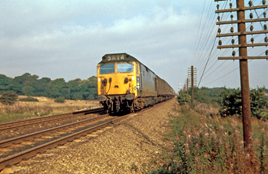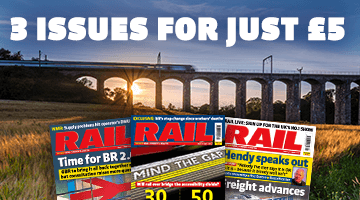Contract negotiations on several fronts began immediately. The financial arrangements were subject to a four-way dialogue involving not only BR and EE but also the MoT and the Treasury and BR noted that these Government Departments proved very difficult because of their attitude to the proposed arrangements.
EE had offered a leasing deal in place of outright purchase and so transfer to BR the benefit of tax relief on capital expenditure that it would not otherwise receive as a nationalised industry. The Treasury was unhappy with this arrangement and blocked it but eventually EE came up with a hire contract for the locos from an EE subsidiary, English Electric Leasing Ltd. The latter bought the fleet from its parent and this is why, from new, the locos bore a plate that advised they were on hire.
Pending finalisation of the contractual arrangements and in order for EE to order long-lead materials, on November 12 BR issued a letter of intent to EE. It took until August 1967 for the contractual arrangements to be formalised.
Detailed planning within EE now got under way, and was co-ordinated by the Traction Sales and Contracts Department, based at Bradford. Component construction was, as usual, split between several constituent parts of EE. The mechanical parts, naturally, were down to Vulcan. Electrical machines fell to Preston while Rugby made the engines (for assembly at Preston or Vulcan) and Bradford was to produce traction motor gear wheels and pinions.
EE’s last tender for Type 4s had been submitted in April 1965 but BR had issued a revised tender specification in August and it contained features not found in either Class 47 or DP2. These included the provision of an electric train supply, train air braking, rheostatic loco braking, multiple-unit and push-pull operation and resilient gears.
BR’s CM&EE then came up with additional requirements, notably slow speed control of the locomotive for merry-go-round workings. EE had developed equipment to compensate for the transfer of the locomotive’s weight onto the rear bogie when starting a heavy train and was keen to try this. BR’s CM&EE agreed the fitting of one set of this equipment would be a good idea to assess its usefulness.
A joint BR/EE decision brought the fitting of inertial engine room filtration instead of oil-wetted filter panels and a 1,000 gallon steel fuel tank, both features increasing overall length and weight. These additional requirements to the August 1965 tender specification were agreed on February 24 1966.
John Dowling, the CME at Vulcan was coming under pressure from EE’s Bradford Traction Sales office over costs. In a rebuttal memorandum of March 28 he admitted that the new design was “challenging” and bore little resemblance to EE’s April 1965 tender for 50 DP2s.
A memo of June 17 from Vulcan to Bradford is uncompromising. It said that the latter had better accept Vulcan’s revised quote for a vital order for both Works. The changes to the DP2 specification eventually pushed up the price from £104,950 to £120,930.
In June 1966 an internal submission was made to the BR Board in the following terms. The hire period for the locomotives was to be seven years, with a series of one-off and quarterly charges. Based on anticipated cost rises in wages and materials during construction, the imputed cost per locomotive by the date of delivery was given as £131,000. Aggregating the charges for the seven years of the hire period would involve an outlay of £168,500. Accounting calculations that adjusted the hire charges to represent a deferment of payment over outright purchase showed this option to be 2½% more expensive but acceptable.
EE offered initially a delivery schedule of 14 months, commencing in January 1967 but this was revised to run from July 1967 until June 1968. Once half the fleet had been delivered, EE would guarantee an availability of 84% (42 locomotives) each day, with a daily penalty of £50 per locomotive for any shortfall.
This figure assumed two locomotives would be undergoing works overhauls, while five would be on routine maintenance at any one time, plus one “spare” for unplanned repair, making eight out of traffic. Reputedly, EE based the calculation on DP2’s performance and the figure was comparable with the availability of EE’s Class 37.
Styling the locomotive exterior involved EE, BR’s CM&EE and the BR Design Office, with an external consultant (Ted Wilkes of Wilkes & Ashmore) engaged to provide input. The consultants had worked for BR previously, including styling Classes 35 and 47.
In February 1966 the Design Office wrote to the CM&EE as follows: “I enclose copies of drawings of the air smoothed locomotive front end, which contributes to the performance of the locomotives at the speeds envisaged. The driver’s vision is not interfered with by distortion caused by excessively curved glass and for this reason it’s placed in the centre of the cab. The driving seat is fairly well in from the bodyside and if it can be moved a little further inwards, able to approach an air smoothed version. If not, unlikely to get much further than e.g. Brush Type 4 and the case for curved glass would be less strong.
The front end will also be affected by alterations you may want for the body section. Wind tunnel tests show it is important to eliminate projections and for visual reasons, hope they can be avoided.
I would prefer the route indicator to be placed below the windows. Perhaps we can try again to get agreement to the use of the small SR version. Should have thought good headlights would have adequately made up for loss of visual warning, resulting from the use of smaller indicators.”
This proposal would have produced a very stylish, possibly futuristic result. Unfortunately, the Design Office seems not to have been briefed on developments in cab design taken forward in 1964 by the CM&EE in consultation with the Railway Inspectorate. A cab mock-up had been produced at Derby and signed off by Brigadier Langley on February 18 1965.
It is unclear whether this was just in connection with a planned new design of EE Type 3 or as a template for all future orders. The plans for further Type 3s were dropped as a result of the March 1965 National Traction Plan identifying a surplus of 77 diesels in this power category.
Possibly at the request of the Inspectorate in order to increase the size of the cab front yellow warning panel, the route indicator box (often referred to as headcode panel) had been moved to above the front windows in the Derby mock-up. No doubt based on experience with earlier designs, where multiple-unit jumpers were on the buffer beam, these connections were now to be at waist height.
Unaware of the Derby mock-up, EE’s Bradford Drawing Office proposed cab styling that featured a wrap-around windscreen, similar to that used on the Trans Pennine DMUs, with the route indicator box set below the windscreens. Whether this was the version submitted by BR’s Design Office to the CM&EE in February 1966 is unclear. On 26 April, however, Vulcan reported to Bradford that matters on cab front design were settled and the Derby mock-up was being followed, further input from the stylist being irrelevant.
Even when EE’s proposed cab styling had been rejected, BR did not supply drawings for the Derby mock-up, so as part of the production of detailed drawings for the entire loco, Vulcan had to produce rudimentary interim sketches of the front end. Unfortunately, these interim drawings were sent to Wilkes & Ashmore, which submitted a critical report on them in April. EE was a bit miffed at the situation.
Both the Design Office and Ted Wilkes wanted as smooth a front end as possible to minimise air resistance and pushed for the route indicator panel to be below the windscreen. Wilkes also suggested a tapering vertical profile but with the styling to focus on the loco’s horizontal lines.
The CM&EE did not yield on the Derby cab mock-up with its roof-mounted route indicator box. The debate over styling rumbled on and in November the CM&EE still wasn’t happy with the proposals for this aspect.
A memo from the BR Design Office in January 1967 expressed frustration at the events within the project, which was described as “an unhappy story”. A major factor had been that the CM&EE had supplied the BR Design Office with the wrong drawings in February the previous year and had therefore been wasting their time!
Throughout early 1967, the Design Office was still trying to get changes made to the indicator box but it was too late because some roof sections had been manufactured already. The foregoing explains why, what might have been something of a styling classic ended up with the new class having nothing better than a purposeful cab outline.















Login to comment
Comments
Howard - 26/11/2017 09:33
'dependent' (the adjective) is not spelt 'dependant' (the noun). Hope that is helpful.
glenna medhurst - 06/12/2017 12:31
Informative interesting article but written like a college essay.